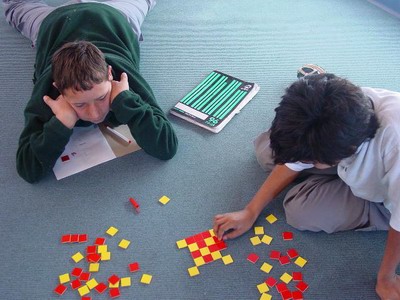Hands-on Maths Experiences
Rachel Boyce
Crossways Lutheran School Ceduna
Rachel describes how Middle Years students in her class have been supported to work, think and speak like mathematicians; and how her class has changed from a quiet room of students going through the motions, to a class of learners and explorers.
Her experiences are particularly relevant to teachers of Indigenous students.
|
 |

 |
During 2004 I had the opportunity to attend a three-day Maths on the Move professional development series**. Maths on the Move involves teachers in exploring problem solving support materials and then taking a sample back to school to trial in the classroom. Stories from the classroom trials are then shared at the following workshop.
Crossways Lutheran School is located in Ceduna and has an Indigenous enrolment of around 63%. Having previously taught at Yirrara College in Alice Springs, a Lutheran boarding college for remote Indigenous students, I was aware of the importance of using hands-on problem solving approaches within a mathematics classroom, particularly with Indigenous students.
The tasks that we examined at the workshop reflected the learning styles of Indigenous students and encouraged them to see and become part of the problem they were solving rather than solving from merely a theoretical perspective. When I returned to my classroom and trialled a few of the tasks, I found that many students were able to explain mathematical concepts that they had previously struggled with. Maths was given meaning, and seemed to be fun at the same time.
|
I approached the school ASSPA committee to purchase the Task Centre Kit for Aboriginal Students, and a year's subscription to Maths300, (an online resource program for teachers that outlines approximately 150 lessons that use a problem solving approach to mathematics). This program has been trialled in a number of Aboriginal schools and the statistical evidence that has emerged is staggering. In Tasmania it was found that the numeracy (and significantly maths literacy) levels of Indigenous students rose sharply to be in line with those of non-Indigenous students over a three year period when students were taught to work and think like mathematicians using the resource. (See INISSS Research below.) Our ASSPA committee purchased the kit and late in 2004 we began using the kit in our classes.
Since that time we have begun the process of allocating Maths300 task lessons across the various class levels, and mapping these lessons against our curriculum framework. Teachers have begun integrating the task-based lessons into their teaching programs and are finding that many lessons rather than using up 'important teaching time' are actually saving time as concepts are grasped much sooner and with greater clarity.
We have set aside in our middle school timetable one lesson a week where students from Years 6-10 are separated into small groups of 5-8 students. In these groups, students explore one of the task cards from the Task Centre Kit for Aboriginal Students with either a teacher or a teacher assistant. (Our teacher assistants are integral to the delivery of this program and their enthusiasm towards its delivery is infectious). Teacher assistants often admit to the students they do not know the answer to problems and together they explore the problem and publish a small report of what they have discovered in the process of examining the problem. For many students this is the most enjoyable maths lesson of the week.
I am finding that students, both Indigenous and non-Indigenous, are more involved in maths lessons and tend to drift together into small groups within the classroom to discuss and argue about what they believe to be the solution to the problems we are examining. This is not teacher-directed and it is a joy to listen to the mathematical language that is being used in the classroom.

Journal writing during a whole class investigation of Task 118, Ice-Cream Flavours. |
Using the task cards and lessons has not saved me time ... however the significant steps that my students are taking towards working and thinking (and speaking) like mathematicians are well worth the time and effort... |
The richness of my lessons has dramatically changed, and my classroom is a classroom of learning and exploration rather than simply a quiet room of students going through the motions.
I do not believe that my lessons before using the kit and Maths300 resource were poor, badly planned or unexciting, however I can feel and hear the difference in my students over the last 6 months.
Using the task cards and lessons has not saved me time, in fact, I still spend hours ensuring the lessons I teach are resourced, run smoothly and will cater for the numerous levels in my class. The planning for our small group work is intensive and has initially taken time to set up, however the significant steps that my students are taking towards working and thinking (and speaking) like mathematicians are well worth the time and effort that has gone into setting up this program, and ensuring that it continues.
**This MOTM series was organised by Lynda Secombe for the South Australian Independent Schools Targetted Programs Authority Inc. Rachel's report was first published in that organisation's pamphlet, Numeracy Update, Term 2 2005.
Reference Links
|
 |
|